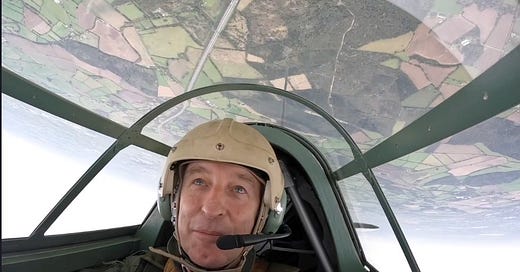Eagle Days
A review of Victoria Taylor's excellent new book on the Luftwaffe and the Battle of Britain
Admit it: how much do you really know about the Battle of Britain? Most Britons of my age asked this would perhaps be affronted by the question: of course we know about the Battle of Britain! We were brought up on it as Mother’s milk; we’ve watched the film/s, read the book/s; climbed on the aircraft at Duxford and watched them fly. Some of us – a lucky few, no doubt – have even flown in a Battle of Britain Hurricane for 40-minutes over the Oxfordshire countryside (see picture!). But all those memories and experiences are meaningless without what Victoria Taylor has brought us in this excellent book, namely the German view of the battle. It does seem amazing that we need to be reminded that it takes two to tango, and yet the Luftwaffe version – or rather, the experiences of the men who served in the Luftwaffe during the battle – remain very much a closed book for most of us.
It is for this and a host of other reasons that Taylor has done the historiography of the battle an enormous favour. I struggle to recall any other book that so comprehensively deals with the Luftwaffe experience of the battle. But the book is much more than this. Taylor has skilfully demonstrated the deep-set ideological motivation of the Luftwaffe. This of course was Nazism, a stupid religion of racial exceptionalism that managed to entangle Germany in its embrace in the 1930s. The young men of the Luftwaffe – flyers, flying crews and ground crews alike - weren’t merely carrying out their national duty on behalf of their country, defending it from its enemies. They were doing so in very large numbers because they were imbued with a fanatical commitment to Nazism’s ideology of hatred and which drove them to extraordinary feats in 1940 (and large numbers of casualties). They so utterly believed in the Nazi cause and their Fuhrer that they made a personal oath of loyalty to him, rather than to Germany.
I had always considered the SS to be the storm trooping warriors of the Nazi vanguard; Victoria Taylor has persuaded me to change my mind. The prototype Nazis were, as Taylor demonstrates, the flyboys of the Luftwaffe, manoeuvring their aerial war horses in combat with ‘the few’ (who, as it turns out, were in fact quite a lot), over London in the hazy summer days of 1940. The idea of the knights of the sky, fighting chivalrously and valorously for duty, national honour and ‘the right’ is a myth that deserves to remain in the rubbish bin. After all, without the eager and enthusiastic warriors of the Wehrmacht in 1939 and 1940 (there were 3-million members of the Hitler Youth in 1935, the first source of the Wehrmacht’s legions) there is no way that that rabid slathering’s of Herr Hitler and his racist cult would have ever been heard beyond Munich’s vomit strewn beer halls. That so many millions of young men (and women) followed Hitler and the Nazis eagerly into Valhalla’s Halls demonstrates the ideological hold that Nazism had on Germany at the time. It was Winston Churchill who in 1935 warned his countrymen that Hitler had, in two years, turned his country into one seeking not honour or national glory, but revenge. He was right. It was revenge that fuelled Nazism, and it was thousands of enthusiastic Nazis who piloted the Messerschmitts and Dorniers over England’s green and pleasant land in 1940, for no other reason than hatred.
Thank you Victoria Taylor for grounding this fascinating military history not in the myth of the ‘knights of the sky’ but in the horror of racial hatred and the war that it created, the most devastating our fragile planet has ever experienced. May we forever be protected from its recurrence.





I think this is a helpful lens from which to view the Battle of Britain. Thanks for sharing.